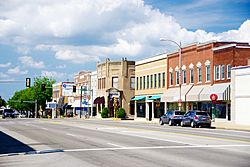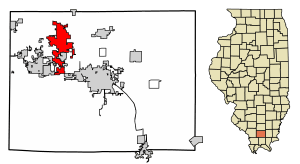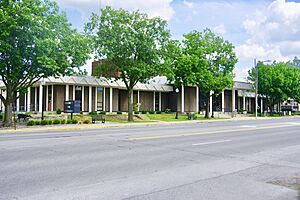Herrin, Illinois facts for kids
Quick facts for kids
Herrin
|
|
|---|---|

N Park Ave (IL 148)
|
|

Location of Herrin in Williamson County, Illinois.
|
|

Location of Illinois in the United States
|
|
| Country | United States |
| State | Illinois |
| County | Williamson |
| Area | |
| • Total | 9.92 sq mi (25.69 km2) |
| • Land | 9.67 sq mi (25.05 km2) |
| • Water | 0.24 sq mi (0.64 km2) |
| Elevation | 420 ft (130 m) |
| Population
(2020)
|
|
| • Total | 12,352 |
| • Density | 1,276.96/sq mi (493.05/km2) |
| Time zone | UTC−6 (CST) |
| • Summer (DST) | UTC−5 (CDT) |
| ZIP Code |
62948
|
| Area code(s) | 618 |
| FIPS code | 17-34358 |
| GNIS feature ID | 2394365 |
| Wikimedia Commons | Herrin, Illinois |
| Website | www.cityofherrin.com |
Herrin is a city located in Williamson County, Illinois, in the United States. In 2020, about 12,352 people lived there.
Herrin is part of a larger area called the Marion-Herrin Micropolitan Area. It's also part of an even bigger region known as the Carbondale-Marion-Herrin Combined Statistical Area, which has over 123,000 residents. This makes it the sixth largest combined statistical area in Illinois.
Contents
History of Herrin
The area where Herrin now stands was first settled by scattered families. It was known as Herring's Prairie, named after Isaac Herring, who was a Baptist preacher and one of the first settlers. Later, his son-in-law, David Herrin, arrived. The similar names eventually led to the area being called just Herrin's Prairie.
Isaac Herring bought the first piece of land in what would become Herrin on November 4, 1816. This was two years before Illinois became a state! He paid $2 per acre for 160 acres.
In 1858, David Ruffin Harrison opened a store on the prairie. During the Civil War, he built a proper store building. He also helped open a post office there on May 26, 1864.
Coal Mining and Growth
After coal was found and mining started in nearby Carterville, people in Herrin also began looking for coal. In 1892, Harrison and his cousins, Ephraim Snyder Herrin and Mrs. Williams, started digging. They found a good amount of coal about 185 feet underground.
In 1895, a railroad company decided to build tracks through the area. David Herrin convinced them to make the line go through Herrin. This helped the town grow a lot. The post office officially changed its name to Herrin Post Office on May 8, 1896.
Harrison and Herrin, who were great-grandsons of Isaac Herring, planned out a new town. They officially created the town map on December 4, 1896. Herrin became a village on March 21, 1898, and then a city two years later on April 17, 1900.
Important Events
Herrin was the site of a sad event in 1922, known as the Herrin massacre, which involved a conflict between miners and guards.
When coal mining made the town rich, Herrin had a fun place called White City Park. It opened on Memorial Day in 1924 and had a saltwater swimming pool, rides, and a theater. Famous big bands, like The Dorsey Brothers, and even Frank Sinatra, performed there.
Several U.S. presidents visited Herrin. President Harry S. Truman came in 1948. Future presidents like Richard Nixon, John F. Kennedy, and Ronald Reagan also visited during their campaigns. Gerald Ford came to the local airport in the 1970s.
Herrin used to have many hotels and stores, including clothing and department stores. Today, Louie's P&R is the only local grocery store that has stayed open.
In the early 2000s, Herrin had a unique experience: two total eclipses of the sun happened there in just seven years! The first was on August 21, 2017, and the second on April 8, 2024.
Geography of Herrin
Herrin is located at 37°48′9″N 89°1′41″W / 37.80250°N 89.02806°W. This is like its address on a map using latitude and longitude.
According to the 2010 census, Herrin covers a total area of about 9.46 square miles (24.5 square kilometers). Most of this area, about 9.23 square miles (23.9 square kilometers), is land. The rest, about 0.23 square miles (0.6 square kilometers), is water.
Population Information
| Historical population | |||
|---|---|---|---|
| Census | Pop. | %± | |
| 1900 | 1,559 | — | |
| 1910 | 6,861 | 340.1% | |
| 1920 | 10,986 | 60.1% | |
| 1930 | 9,708 | −11.6% | |
| 1940 | 9,352 | −3.7% | |
| 1950 | 9,331 | −0.2% | |
| 1960 | 9,474 | 1.5% | |
| 1970 | 9,623 | 1.6% | |
| 1980 | 10,708 | 11.3% | |
| 1990 | 10,857 | 1.4% | |
| 2000 | 11,298 | 4.1% | |
| 2010 | 12,534 | 10.9% | |
| 2020 | 12,352 | −1.5% | |
| U.S. Census | |||
The table above shows how Herrin's population has changed over the years, based on information from the U.S. Census. You can see how the number of people living in Herrin has grown and changed since 1900.
Sister City Connection
On July 17, 2015, Herrin became "sister cities" with Cuggiono, Italy. This means the two cities have a special friendship and work together to share culture and ideas. Mayors Steve Frattini of Herrin and Flavio Polloni of Cuggiono signed an agreement to make it official.
 – Cuggiono (Milan, Lombardy, Italy) (2015)
– Cuggiono (Milan, Lombardy, Italy) (2015)
Fun Events and Festivals
Herrin hosts an exciting event every year called HerrinFesta Italiana. It's a five-day celebration of the town's Italian heritage, held during Memorial Day weekend. Over 60,000 people often come to enjoy the fun!
The festival features:
- Live music from famous artists and bands
- Delicious Italian food
- A carnival with rides and games
- A Bocce Ball tournament (Bocce Ball is a fun Italian game!)
- Hilarious "Bigga Nose" and pasta-eating contests
- Many other activities for everyone to enjoy.
Some of the bands and artists who have performed at HerrinFesta Italiana include Survivor (band), Dixie Chicks, Night Ranger, Blake Shelton, Blue Öyster Cult, Florida Georgia Line, Eddie Money, The Guess Who, Kansas (band), Starship (band), Papa Roach, Saving Abel, Theory of a Deadman, Foreigner (band), and Collective Soul.
Famous People from Herrin
Many interesting people have connections to Herrin:
- E. N. Bowen was an Illinois state lawmaker, judge, and lawyer.
- Ray Chapman was a famous baseball shortstop for the Cleveland Indians in the early 1900s. He grew up in Herrin.
- Richard Clarida served as the Vice Chairman of the Federal Reserve, which is a very important role in the U.S. economy.
- Ora Collard was an Illinois state representative and a businessman who grew up in Herrin.
- Steve Fisher is a well-known basketball coach who was born in Herrin. He coached the Michigan national championship team.
- David Lee Murphy is a popular country music artist.
- Joseph W. Ozbourn received the Medal of Honor, a very brave award.
- Jim Ranchino was a political scientist and consultant. He was born and raised in Herrin.
- William R. Tonso was a professor of sociology.
- Bobby Veach was a baseball outfielder for the Detroit Tigers in the early 1900s. He started playing semi-pro baseball in Herrin.
- Douglas R. Odom is a famous pianist and author.
See also
 In Spanish: Herrin (Illinois) para niños
In Spanish: Herrin (Illinois) para niños


